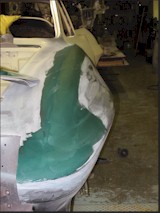Dave65
Well-known member
The problem is some of these rivets are deep in the interior of the body...meaning that you more or less need two people. One on top of the rivet to hold it in place, and the other on the other side of the car with the punch and hammer.
Chris,
I know where the rivets are, I am refinishing the body reinforcements on the 65 Convertible I am working on. It does required two people but with the body off I think I think they are all accessible. The head of the rivet is inside the body and the bucking bar, which is farly small, will (I think) fit on the shaft side of the rivet. The correct way is with the gun on the head of the rivet and the bucking bar on the shaft side. It would be much harder if you were trying to hammer on the shaft side.
Dave










